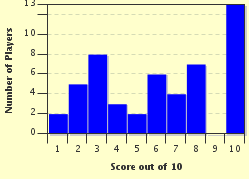Quiz Answer Key and Fun Facts
1. Ochres, which come in shades of yellow, red and brown
2. Carmine, a bright red pigment also known as cochineal, sometimes used for red food coloring
3. Tyrian purple, a pinkish-purple shade that was very expensive in ancient times
4. Ultramarine, a deep blue whose name tells us it needed materials that were far away from European users
5. Indian yellow, a color that was often used for sunlight in paintings of the 17th and 18th centuries
6. Prussian blue, the color traditionally used in blueprints
7. Mauveine, also known as aniline purple and Perkin's mauve
8. Verdigris, the green color that covers many statues, such as the Statue of Liberty
9. Vermilion, a red-orange color often seen in Renaissance paintings
10. Fuchsine, whose color is often described as magenta
Source: Author
looney_tunes
This quiz was reviewed by FunTrivia editor
rossian before going online.
Any errors found in FunTrivia content are routinely corrected through our feedback system.

